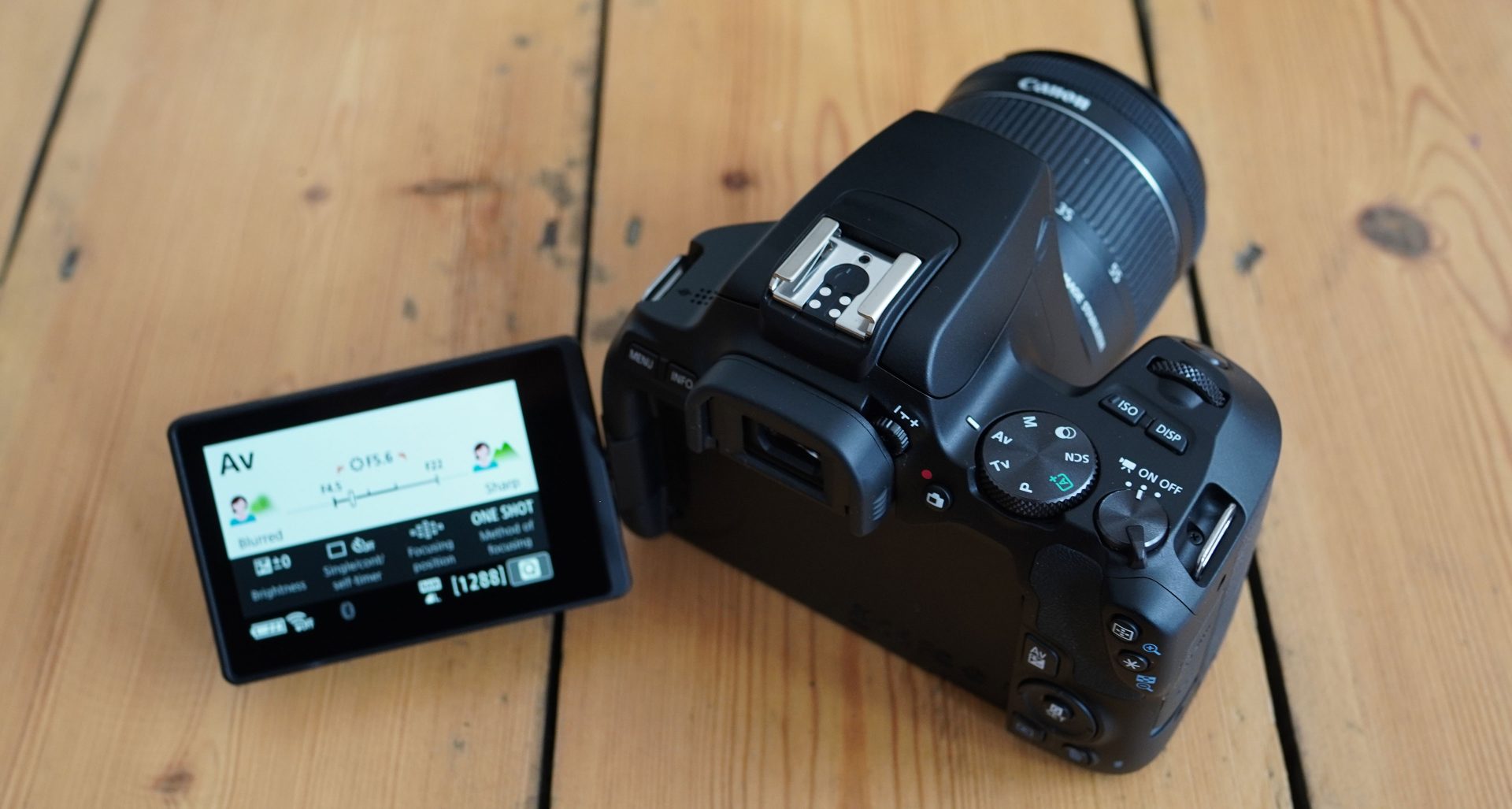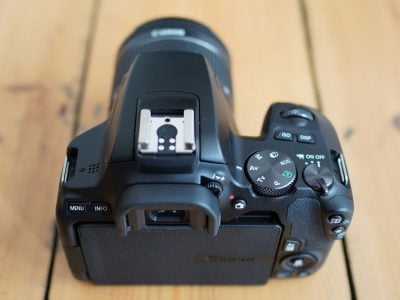Canon EOS 250D Rebel SL3 review
-
-
Written by Gordon Laing
Intro
Canon’s EOS 250D, or Rebel SL3 as it’s known in North America, is a compact DSLR aimed at photographers buying their first interchangeable lens camera. Announced in April 2019, it replaces the two EOS 200D / SL2, and like that model offers a more sophisticated point-of-entry than the cheapest DSLRs and a smaller body to boot.
Available in black, white or silver, the EOS 250D / SL3 is the smallest and lightest DSLR with a fully-articulated touchscreen. The 24 Megapixel APSC sensor is the same as the EOS 200D / Rebel SL2 before it, which means you also get Dual Pixel CMOS autofocus, allowing it to smoothly and confidently refocus in live view and movies (at least at 1080p). As before, there’s also a small optical viewfinder with a basic 9-point AF system and 5fps burst shooting, as well as a 3.5mm input for connecting an external microphone and Bluetooth to complement the Wifi for easy location tagging, remote control and wireless transfer of images.
So far so similar to its predecessor, but new to the EOS 250D / Rebel SL3 is the DIGIC 8 image processor, which brings eye-detection in live view (a first on a Canon DSLR) and 4k movie recording at 24 or 25p, although like the EOS M50 mirrorless camera there are some severe limitations: when shooting in 4k, the EOS 250D / SL3 imposes a tight crop and also loses Dual-Pixel AF, so the autofocus instead uses a less confident contrast-based system. 1080 video is at least available at 25, 30, 50 or 60p though, and the maximum recording time in any mode is 29:59. Like the M50, the 4k restrictions are frustrating, but there’s no getting away from the fact the EOS 250D / SL3 remains a compelling option for vloggers with a flip-screen, mic input and great autofocus, at least in 1080p, all packed into a small and light body at an affordable price. That said, if you don’t need the DIGIC 8 updates, I’d compare prices closely with the earlier EOS 200D / Rebel SL2, which also still supports 1080 at 24p – I’ve popped links below to help! I’ve filmed two videos for this review which demonstrate all the features in practice: the first, below, is my complete in-depth review (available at 12-noon GMT Monday 6 May), and below that a second video dedicated to testing the 250D / SL3 for vlogging. Below the videos are some highlights if you prefer to read rather than watch!
Check prices on the Canon EOS 250D Rebel SL3 at Amazon, B&H, Adorama, or Wex. Alternatively get yourself a copy of my In Camera book or treat me to a coffee! Thanks!
Check prices on the Canon EOS 200D / Rebel SL2 at Amazon, B&H, Adorama, or Wex. Alternatively get yourself a copy of my In Camera book or treat me to a coffee! Thanks!
Check prices on the Canon EOS M50 at Amazon, B&H, Adorama, or Wex. Alternatively get yourself a copy of my In Camera book or treat me to a coffee! Thanks!
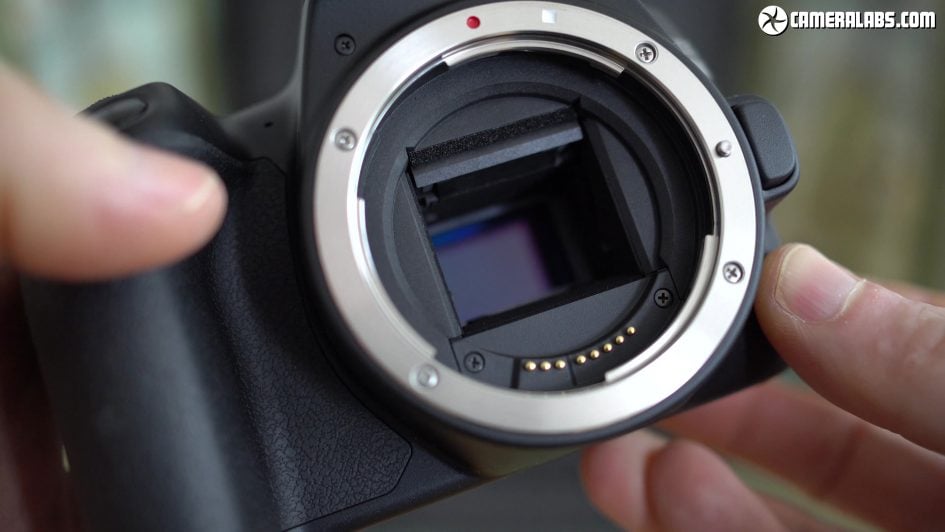
Above: The 250D is equipped with the same 24 Megapixel APSC sensor as its predecessor, which employs Canon’s excellent Dual Pixel CMOS autofocus for movies and live view, allowing it to smoothly and confidently refocus, at least when filming in 1080p. Like all Canon bodies to date, there’s no sensor-stabilisation with the 250D instead relying on optically stabilised lenses to iron-out any wobbles. If you’re filming video, you can apply optional digital stabilisation, but at the cost of cropping the image – you can see it in action in my separate video about vlogging with the 250D / SL3.
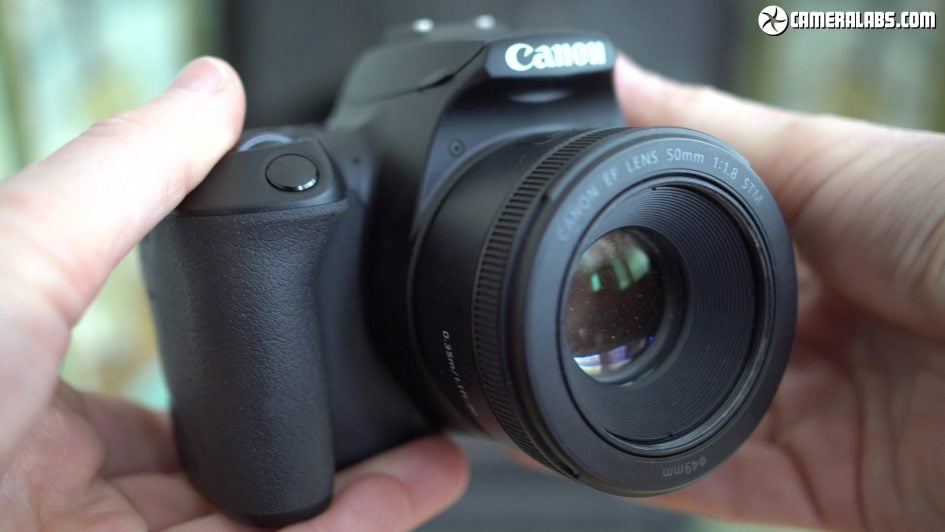
Above: It’s easy to gloss over the lens mount on a budget DSLR, but Canon’s EF mount gives the 250D access to one of the largest lens catalogues around which crucially includes some very affordable options. One of the first lenses you should consider after the kit is the EF 50mm f1.8 STM, ideal for portraits and exploring shallow depth-of-field effects with blurred backgrounds. It costs around 130 pounds or dollars, much cheaper than equivalent native lenses for mirrorless systems. If you’re into vlogging or ultra-wide photography, the EF-S 10-18mm is also cheaper than Canon’s mirrorless equivalent. Meanwhile the APSC sensor reduces the field of view of all lenses by 1.6 times, so the 18-55mm zoom becomes equivalent to 29-88mm, while the 50mm becomes 80mm which is perfect for portraits.
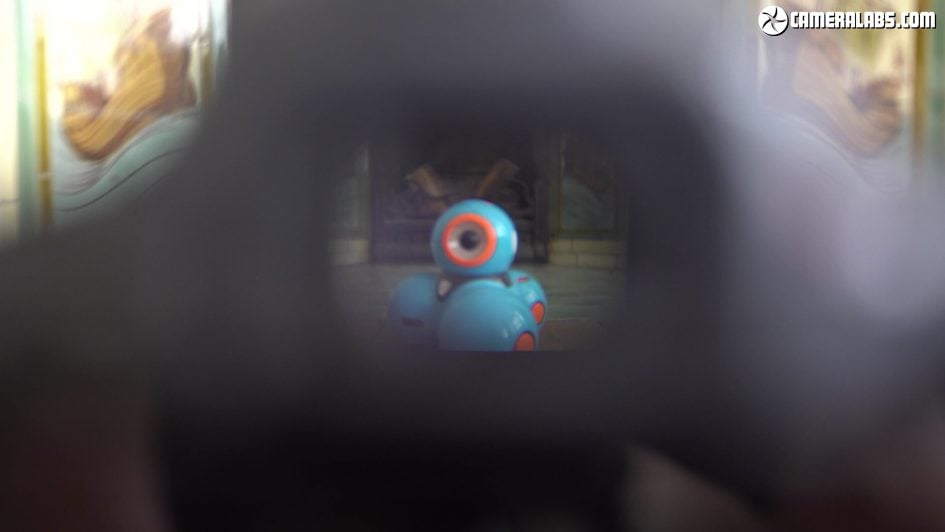
Above: As a DSLR, the 250D employs an optical viewfinder, and when using it, the camera is limited to a basic 9-point autofocus system. The major benefit of an optical viewfinder is low battery consumption, which allows the 250D to shoot up to 1000 images per charge, roughly three times more than when using the screen in live view. But unlike electronic viewfinders on mirrorless cameras, you won’t enjoy face or eye detection across the frame, the chance to preview effects like black and white, or the ability to film movies or playback images. It’s a personal choice, but I much prefer trading battery life for the flexibility of electronic viewfinders, and when testing the 250D rarely found myself using the optical viewfinder due to its inferior experience.
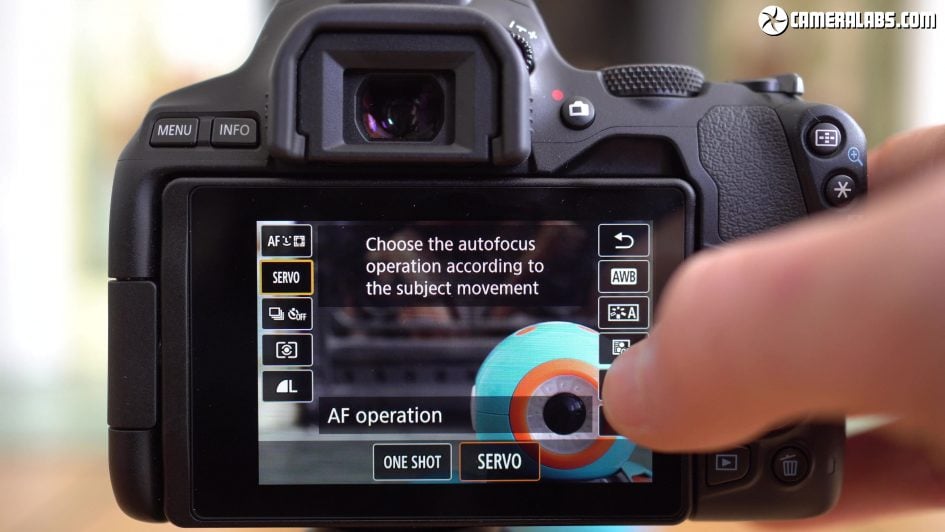
Above: If you enable live view, you can use the touchscreen for composition, allowing the camera to focus almost anywhere on the frame, as well as supporting face and eye detection. Canon’s touch interface is one of the best around, letting you tap your way through the quick or main menu system, swipe through images in playback as well as double-tapping or pinching to magnify.
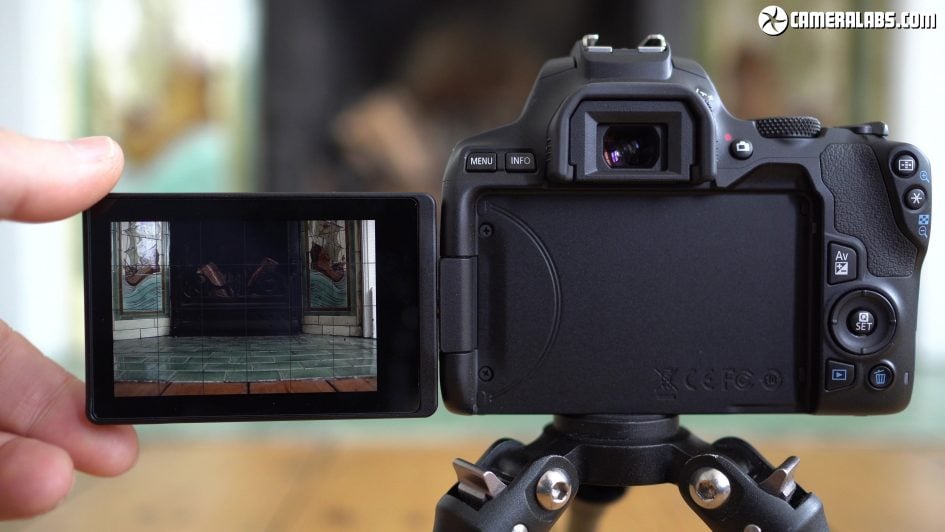
Above: Like the 200D, the screen is side-hinged and fully-articulated, allowing it to flip out and twist to almost any angle. Great for composing at high or low angles whether in the landscape or portrait orientation, as well as back on itself for protection, or facing forward for selfies or vlogging. Canon continues to be one of the few companies to regularly fit fully-articulated screens, and the 250D becomes the smallest DSLR to feature one. As someone who films a lot of pieces to camera, I find them incredibly useful.
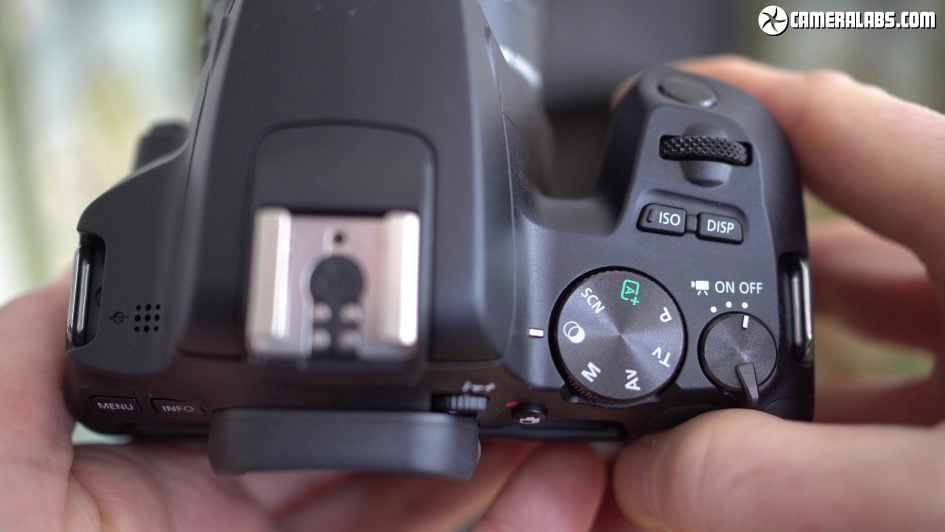
Above: At first glance the top panel looks similar to the earlier 200D, but Canon’s simplified a couple of items. There’s no longer a Wifi button on the left side, while the flash-off and creative auto modes have been dropped from the main dial. But you still have Creative Effects, Scene presets and full Auto, along with the traditional PASM options. Behind the clicky shutter release button is a finger dial – the only control wheel on the camera – along with ISO and DISP buttons and a rotary power switch which sets the camera for photos or movies. The ISO button is dedicated to sensitivity, but the DISP button can be customised from turning the screen on and off to previewing depth of field, firing up the Wifi, maxing the screen brightness or pausing movie autofocus.
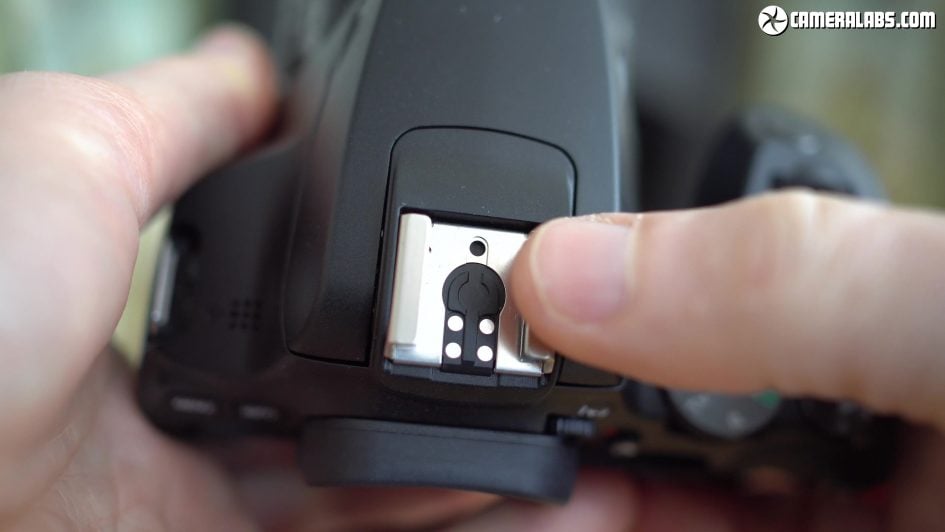
Above: Bonus points for anyone who noticed something else missing from the top: the traditional large sync pin in the middle of the hotshoe. Like Canon’s entry-level 2000D and 4000D models, this prevents the 250D from syncing with third party lights and flashes that rely on it. Canon’s own EX Speedlites still work, but I think it’s a bit mean to remove it, especially since it was present on the previous 200D not to mention the M50.
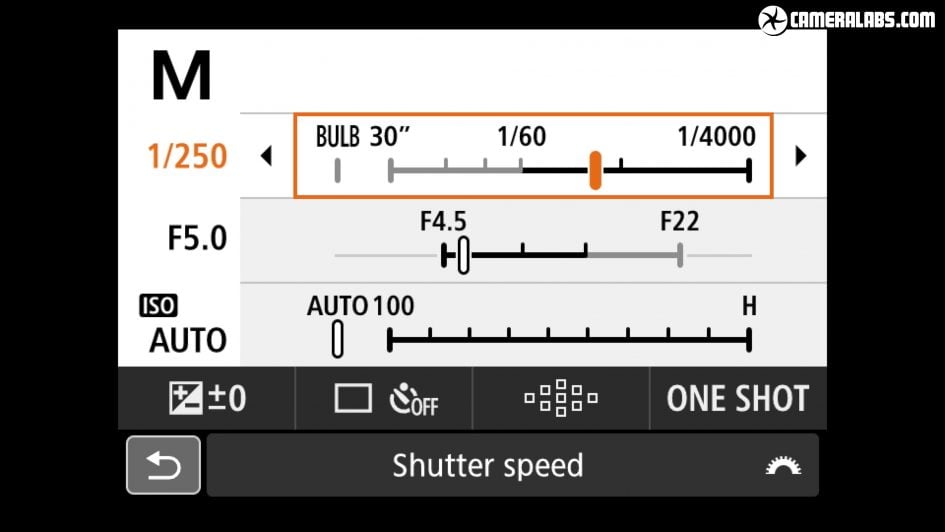
Above: The 250D inherits the helpful guided interface of the 200D which presents a bunch of common settings for each shooting mode along with a slider for its core adjustment on the screen. So in Program mode the slider adjusts exposure compensation, in Aperture Priority it adjusts the aperture, in Shutter Priority it’s the shutter speed and in Manual it’s the aperture and shutter, and in each case there’s helpful icons telling you what effect the slider will have. Meanwhile below the slider are icons for adjusting things like the drive and focusing modes. It’s a helpful interface for exploring creative control, but easily switched for a more traditional info screen if preferred.
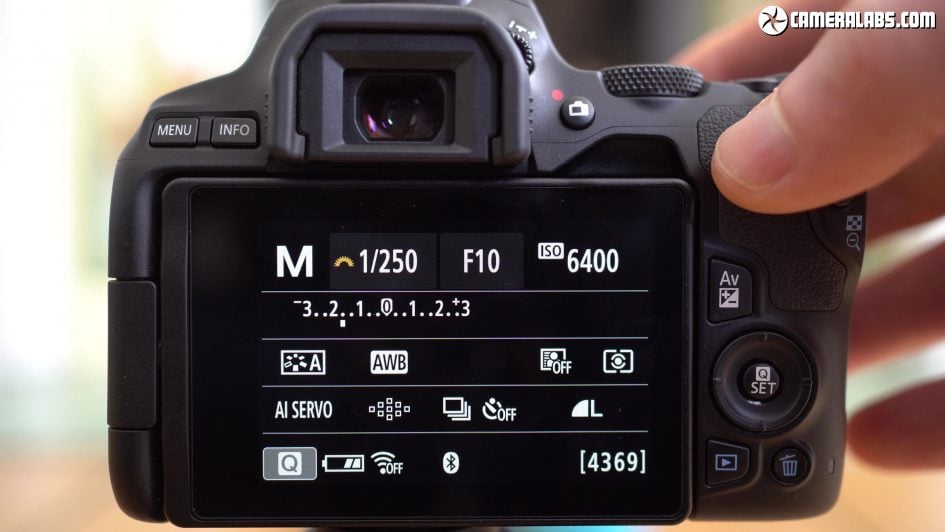
Above: Round the back, the controls are the same as the 200D, including dedicated buttons for exposure compensation, AF area adjustment and live view.
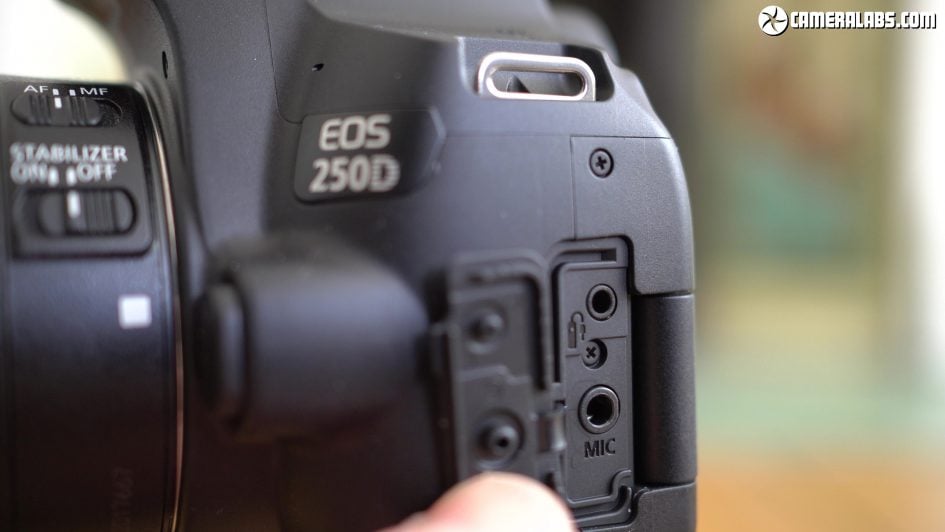
Above: Behind a flap on the left side are ports for a remote cord and a 3.5mm microphone input, the latter cementing its credentials as one of the best vlogging cameras for the money.
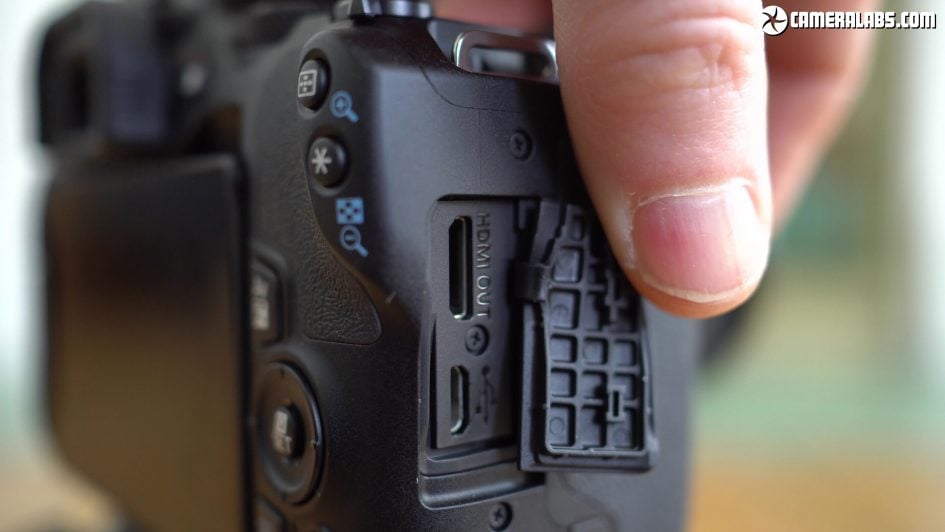
Above: On the right side are Mini HDMI and Micro USB ports, the USB doubling-up for analogue video output but sadly not to charge the battery internally, while the HDMI now offers a clean output if desired in 1080 or 4k resolution. I think this is Canon’s cheapest camera to offer it.
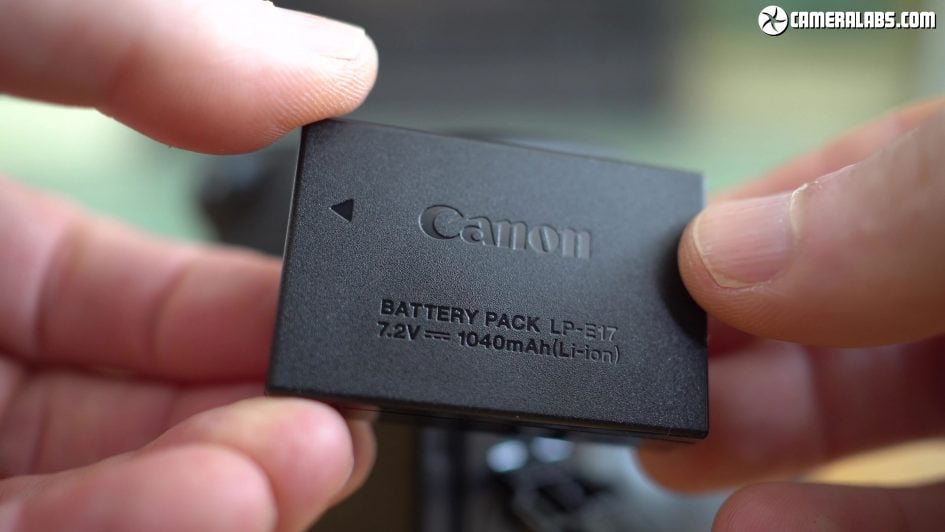
Above: Speaking of the battery, the 250D is powered by the same LP-E17 pack as its predecessor, although if you’re using the optical viewfinder, Canon reckons you can now squeeze up to 1000 shots per charge. Switch to live view and you’re looking at around 300, although both figures remain an increase over the 200D. I was also able to film three hours of 1080p video across six clips on a single charge before the icon started to flash. The battery compartment is also where you’ll find the SD memory card slot.
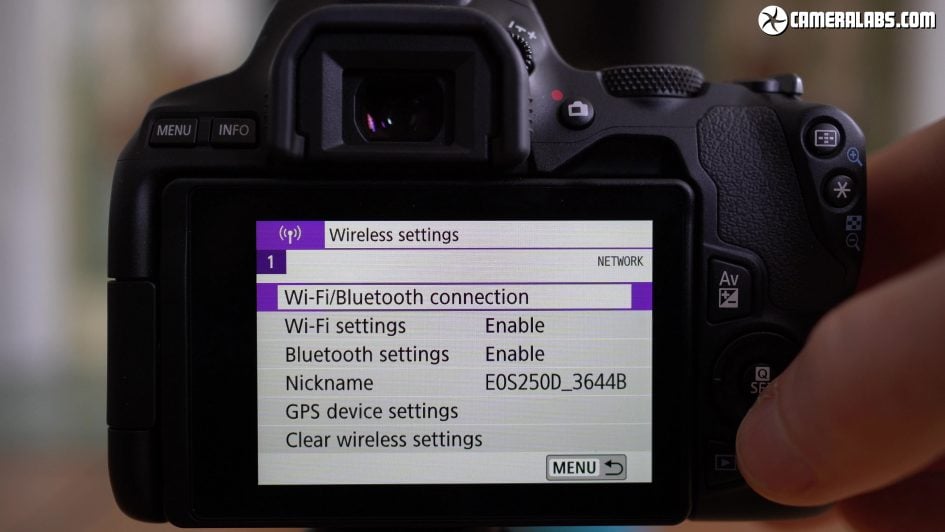
Above: The 250D may lack the physical wireless button of the 200D but the capabilities remain the same. A low power Bluetooth connection keeps your phone connected with the camera, automatically embedding GPS locations as you shoot if desired, and supporting a simple but responsive remote control button in the app to shoot photos or movies. If you prefer remote control with live view or to wirelessly transfer images or videos, the Bluetooth can also configure a faster Wifi connection for you. There may be nothing new here, but Canon’s wireless implementation remains one of the easiest and most capable.
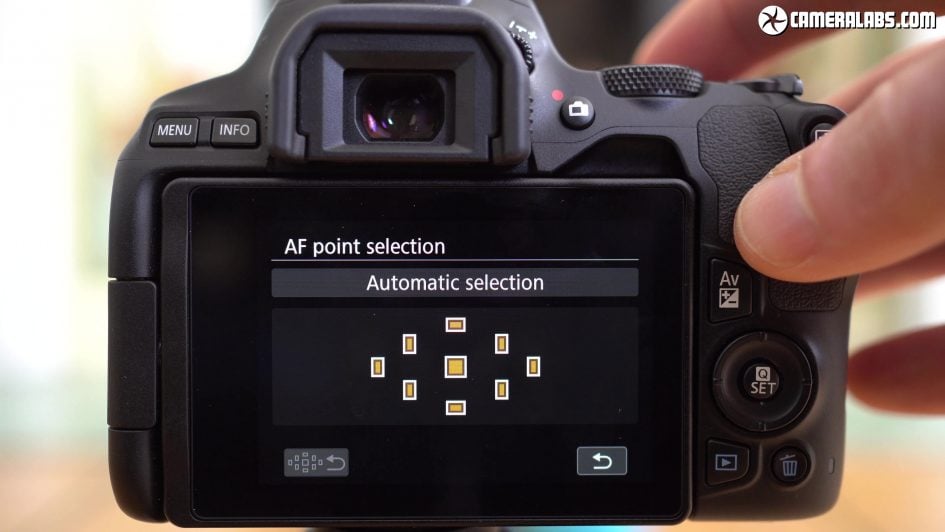
Above: In terms of autofocus, there’s a basic 9-point system concentrated in a diamond pattern when shooting through the viewfinder…
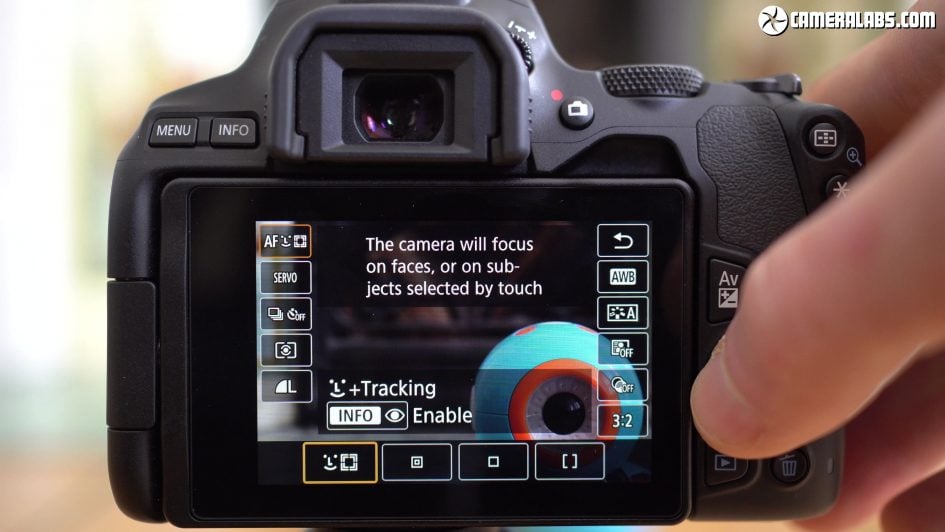
Above: …or dual pixel CMOS AF in live view which works across most of the frame and also supports face detection now with the option to additionally enable eye detection.
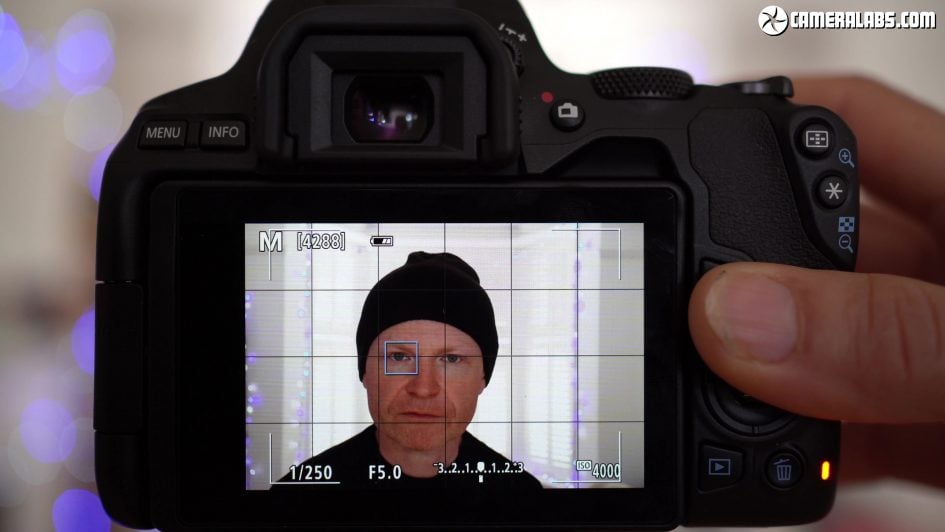
Above: Here’s the 250D shooting in live view with face and eye detection not only telling the camera where to focus, but also what to expose for. In my tests using the optical viewfinder, backlit portraits were often underexposed due to lack of face detection, but this was never a problem when shooting in live view. In short, the 250D is a lot more foolproof in live view as it can exploit a broader focusing area and more sophisticated metering
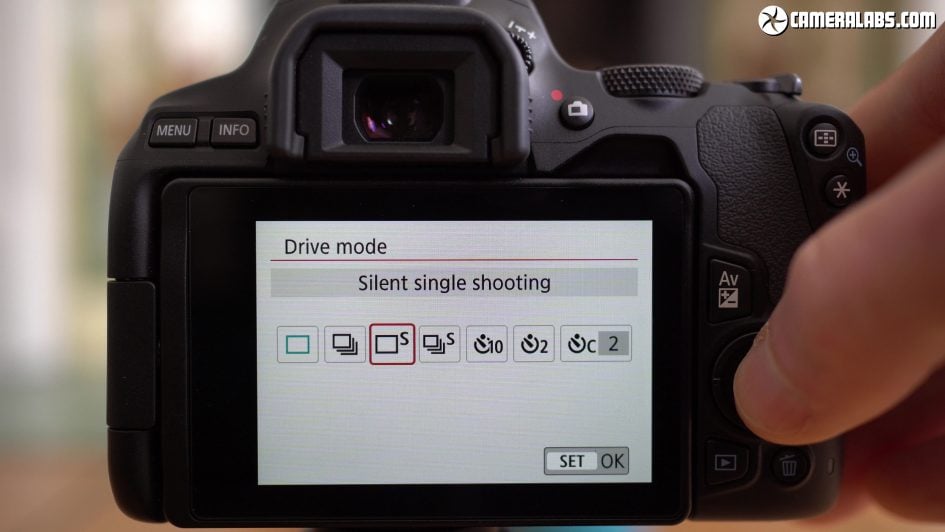
Above: The 250D has a silent drive mode, although like other DSLRs it can’t help but make some noise as the mirror and mechanical shutter open and close. So silent mode is quieter, but not silent by any means. For true silence you need an electronic shutter option in live view as provided by most mirrorless cameras.
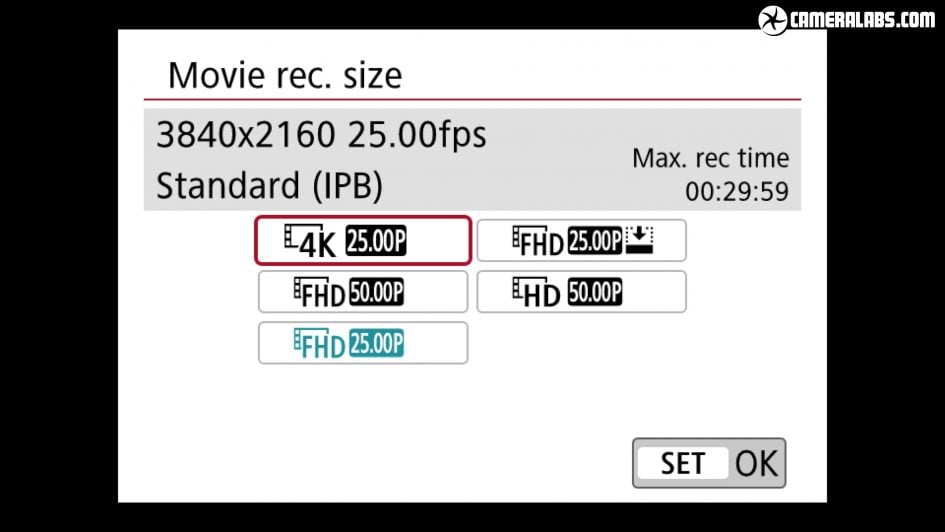
Above: Moving onto video, the EOS 250D can film 720 at 50 or 60p, 1080 at 25, 30, 50 or 60p, and in an upgrade over its predecessor, you can now film 4k at 24 or 25p, but sadly there’s no high-speed video for slow motion. In any mode, the maximum clip length is a second shy of half an hour, but there are a number of limitations. First is the removal of 1080 at 24p, a mode offered on the 200D and M50 when set to NTSC video, but strangely absent here and on the EOS RP. 4k is available at 24p when set to NTSC but as you’ll discover, it’s not always desirable to film in this mode and downconvert to 1080 in post.
Check prices on the Canon EOS 250D Rebel SL3 at Amazon, B&H, Adorama, or Wex. Alternatively get yourself a copy of my In Camera book or treat me to a coffee! Thanks!
Check prices on the Canon EOS 200D / Rebel SL2 at Amazon, B&H, Adorama, or Wex. Alternatively get yourself a copy of my In Camera book or treat me to a coffee! Thanks!
Check prices on the Canon EOS M50 at Amazon, B&H, Adorama, or Wex. Alternatively get yourself a copy of my In Camera book or treat me to a coffee! Thanks!
